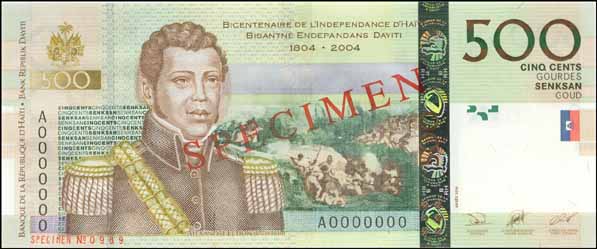The 500 Gourdes features a new portrait of General Alexandre Sabès Pétion with Fort Jacques at Fermathe on the back.
Pétion was born 2.4.1770 in Port-au-Prince a free man, the son of a wealthy French colonist named Pascal Sabès and a mulatto mother named Ursule. One story of how he got his last name was that as a small boy he
was called “Petit-Homme” which when said quickly sounded like Pétion. The official explanation is that it came from Pétion Villeneuve, a member of Friends of the Blacks.
He studied mathematics and was an accomplished silver and goldsmith. Pétion  joined the militia at age 18 and as a result of his diligence and knowledge of mathematics, became one of the best artillerymen of his time. He became a lieutenant in 1791 reporting to General André Rigaud and later commanded the artillery. He rose to the rank of general
in Toussaint's army and on 11.3.1807 he was elected President of the Republic of Haïti and on 2.6.1816 declared president for life. He died March 29, 1818 at Port-au-Prince. joined the militia at age 18 and as a result of his diligence and knowledge of mathematics, became one of the best artillerymen of his time. He became a lieutenant in 1791 reporting to General André Rigaud and later commanded the artillery. He rose to the rank of general
in Toussaint's army and on 11.3.1807 he was elected President of the Republic of Haïti and on 2.6.1816 declared president for life. He died March 29, 1818 at Port-au-Prince.
When I first saw a PROOF version of this new 500 Gourdes banknote I wasn't sure it was from
Haïti. I sent a picture to Murray Hanewich, the editor of “Inside IBNS” who lives in Alberta, Canada. Murray’s comment was that it looked like Canada’s recent banknote designs. I mentioned his comments to Daniel Elie, the designer of
this series, and asked him about his design inspiration for these new notes. His comments were very interesting: “Your Canadian expert (the "Inside IBNS" Editor) is quite right,
the first banknotes I consulted was the
last Canadian issues and the Euros. Both have the same design parameters required for modern banknotes. And I also consulted with a Canadian designer - a Polish immigrant - who is a design teacher at UQUAM (University of Quebec at Montreal), specializing in banknote design.
Surely, I must have been influenced by those designs.” Murray was pleased to hear his initial impressions were in fact right on target.
Also another first for Haïti, each banknote, except for the 10 Gourdes, contains the Haïtian flag. They also utilize Braille characters and a wide security strip similar to that used on the 20 Gourdes 2001
Constitutional Commemorative issue. For map collectors, there are small cartographic depictions of Haïti appearing on the metalized strip.
Haïti’s victory over the French had wide geopolitical consequences. The only nation in history where slaves had risen up to throw out their masters, caused introspection in the US (still a slave holding nation). It dashed Napoleon's grand plan of a colonial empire in the
Americas, “ the army which was needed to hold it had been destroyed in insurrections in San Domingue (Haïti).”(2)
France subsequently abandoned its colonial ambitions in the Americas and sold the Louisiana Territory to the US on April 30, 1803 for $15,000,000.
For Haïti it was a bittersweet victory. France withheld recognition of the new state and in fact imposed very harsh measures which lasted
for many years. In 1825 France finally agreed to recognize the new nation but exacted a great financial penalty which has been referred to as the 1825 millstone. Some scholars site these harsh measures as a significant factor in Haïti's perpetual poverty. Just prior to his resignation, President Aristede sued the French government for $21 Billion for reparations based on the crushing measures imposed on Haïti by the French government.
The Haïti bicentennial series was printed by Giesecke + Dievrient in Germany. The conception, design and historical investigation of the bicentennial series was
done by Haïtian architect and painter, Daniel Elie. Noted Haïtian portraitist Barbot contributed the free interpretation of Sanite Belair, while the Dessalines and Cappoix portraits were based on contemporary gravures. Lawyer and member of IBNS and LANSA, Joseph Guerdy-Lissade, provided both historical and numismatic analysis and support to the designer, Daniel Elie.
Hopefully, with the assistance of international support, stability can again be achieved in the country. It now appears that the legislators are finally in place and these important symbols of Haïtian independence and history should be available for everyone to see starting in August of 2004. And for the first time, with the use of Kreyòl
on the bicentennial series, they will also be widely understood.
Bibliography:
(1) Written in Blood , Robert Debs Heinl & Nancy Gordon Heinl, 1978 Houghton Mifflin Co, ISBN 0-395-26305-0
(2) The Story of Haïti, Harriet Gibbs Marshall, 1930, Christopher Publishing House
(3) The Black Liberator, Life and Times of Touissant L’Overture, Seldon Rodney
© Garry Saint, Esquire 2004, All Rights Reserved
<Previous Page | 1 | 2 | 3 | 4
| 5 |
Home |
Catalog Index | Haiti Index | Articles | Links | Contact Us

Site © Garry Saint, Esquire 1999-2004
|